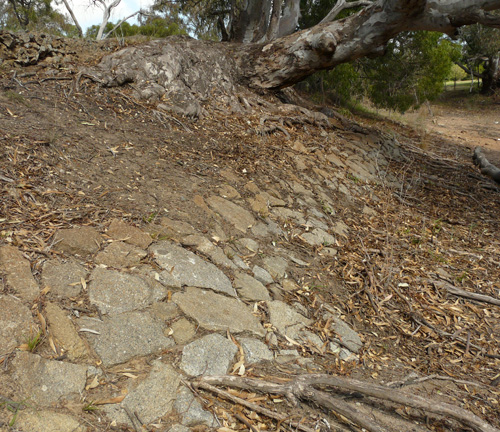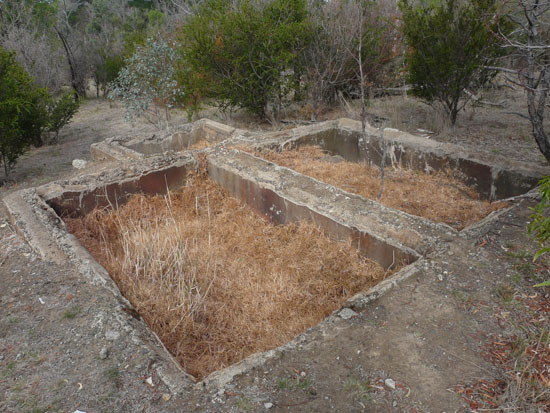
Water supply deserves a page of its own since the only structures remaining from the Sanatorium are the dam and some concrete tanks, and since the lack of water should have prevented the place being built in the first place.
Water was a problem as soon as the Sanatorium opened. In Aug 1905 it was noted that there were two or three rain water tanks which were not sufficient, and that water had to be carried from stations on the Essendon to Broadmeadows line. Some sort of water purification was being done, presumably of dam water.
The dam predates the Sanatorium, being shown on an 1869 map. It was downstream from the Sanatorium, so it would have become polluted very quickly. By 1907 a drain had been cut so that run-off from the Sanatorium (and presumably the hill behind it) did not go into the dam. Already there were calls for the construction of a 4 mile pipeline from Broadmeadows (now Westmeadows) to supply water from the Yan Yean reservoir, but this was considered too expensive at the time.

In 1912 two bores were sunk to a depth of greater than 190 feet, and windmills erected. In 1913 one of these had gone dry, and the other one was said to give a "casual sort of trickle". At the same time the dam was described as a muddy yellow waterhole, and the patient's bed quilts were said to be soiled because there was not enough water to wash them. A pipeline from Sunbury had been discussed but was too expensive. Instead water was piped from two new bores which were the other side of Mickleham Road, north of Bonds Lane.
In April 1923 patients were being sent home because the tanks were almost empty. Presumably the new bores had also failed. The dam had been drained the previous winter so that it could be enlarged, and had not had time to fill again before the summer. Ben Chaffey, owner of Woodlands, had offered to supply water from his dams but this had been refused.
The following year the Chief Secretary said that Greenvale Sanatorium would have to be "abolished" because it was too remote and there was no water supply.
In 1927 nurses were going to the city once a week to have a bath. The tanks at the Sanatorium were said to be contaminated by possums and birds. Two carts were being used to bring water at a cost of £3 per day. The Minister for Health stated in June that the buildings were dilapidated and would cost £5000 to put in proper order, while a water supply would cost £2000.
Mains water was finally made available in 1929 when a 3 inch cast iron pipe was laid from Westmeadows. This pipe passes through what is now the back paddock. When the Percy Everett building was completed the water supply was inadequate and a 6 inch fibre-cement pipe was laid through the Back Paddock and the Police land to Mickleham Road. Both pipes can be seen where they cross the dam spillway. They both appear to have discharged into the partially buried concrete tank, from where water was presumably pumped to the top of the hill. This was necessary because the mains pressure was enough to reach the dam (height above sea level 430 feet) but not enough to reach the buildings (for some reason the laundry had been placed at the very top of the site, about 495 feet above sea level).
The pump would have been in the adjacent shed, which also contained a pump for dam water. The shed was demolished illegally in 2005.
A third pipe can be seen crossing the creek upstream from the dam. This may be the pipe from the second set of bores sunk in 1914. On the other hand it may have been to supply the new dairy which was built years later the other side of Providence Road and known to have been supplied with water from the Sanatorium.
At the time of demolition both of the original water mains had been superseded by a new pipe running directly from Providence Road to the large water tower.